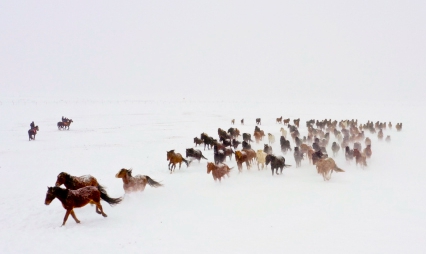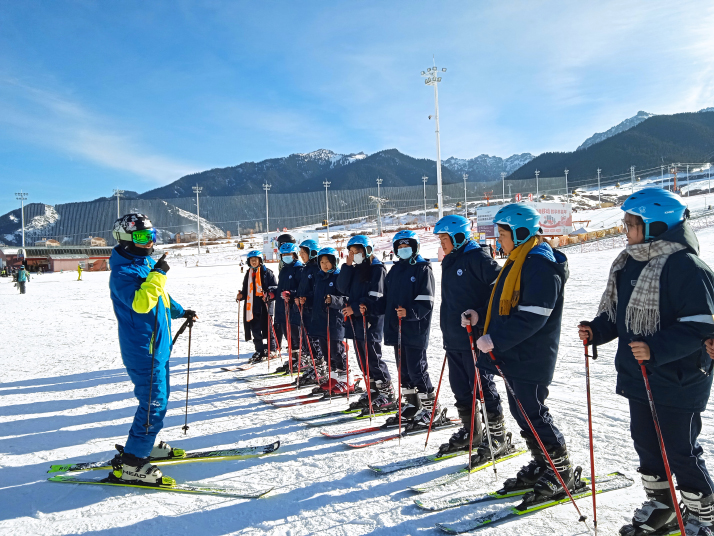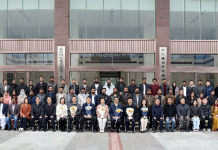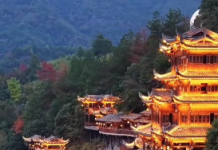
“I like skiing. In addition to learning it as part of our school curriculum, I often go skiing with my dad right here,” Ahqy Sarsbek, an eighth grader from the Kazak ethnic group, said.
In recent years, Xinjiang has set a goal to become an ice and snow sports plus tourism paradise.
Popularizing winter sports among students is one of the measures it has taken to boost public participation.
Young blood
Zhao Rui, a teacher at Miaoergou Middle School, told Beijing Review that every year, her school receives funding specifically for winter sports education. In her view, the benefits are manifold, such as improving students’ physical wellbeing, building character and discovering potential professional athletes.
Like northeast China, Xinjiang in the northwest is located in a so-called golden latitude zone for ice and snow. This zone, comprising areas roughly located along the 45-degree north latitude, features world-renowned winter sports destinations such as the Alps and the Rocky Mountains.
Altay, the northernmost prefecture in Xinjiang, is recognized as the birthplace of skiing, the history of which can be traced back there 12,000 years. Urumqi, the regional capital of Xinjiang, sits at the northern foot of the Tianshan Mountains, a mountain range that bisects Xinjiang, and boasts numerous attractions for skiers and tourists.
“We have established long-term partnerships with schools offering ice and snow courses in Urumqi,” Huang He, Deputy General Manager of the Silk Road Mountain Resort, said. “We also offer student skiers special packages. These programs aim to motivate more young people to fall in love with winter sports.”
With a population of more than 25.8 million, Xinjiang is home to all 56 of China’s ethnic groups. The four largest ones are the Uygur (11.6 million), the Han (10.9 million), as well as the Kazak and the Hui, each with a population upward of 1 million, according to data from the seventh national census conducted in 2020.
Holiday haven
In August 2022, the Xinjiang Uygur Autonomous Regional Government issued a 2022-25 action plan on promoting ice and snow sports and tourism. The plan calls for building more skiing and skating facilities, making winter sports more popular, developing skiing-themed holiday destinations and turning the ice and snow industry into a new growth pole of the region.
The Silk Road Mountain Resort is a case in point.
The resort caters to diverse demands. It offers training to new learners. Its challenging slopes beckon seasoned aficionados. It is also a paradise for those who simply want a retreat from the hustle and bustle of city life, to enjoy outdoorsy things such as hiking or motorcycling as well as a range of entertainment programs.
Making his foray into the business 20 years ago, Chairman Li Jianhong, a skiing enthusiast in his own right, was a bit ahead of his time.
The resort was in the red for 11 years before finally turning a profit. Now, visitors are pouring in from Urumqi and big cities in the country’s east like Beijing and Shanghai.
It is also attracting tourists from Russia and Central Asian countries, as its prices are lower than those of European counterparts. Li said some 10 percent of visitors in 2023 came from these countries.
The Olympic and Paralympic Winter Games Beijing 2022 achieved the goal of involving more than 300 million Chinese people in snow and ice activities, creating huge business opportunities, Li said. His company employs nearly 800 people as coaches, rescuers and hotel staff, 70 percent of whom are from nearby villages.
Villagers also run homestay businesses to capitalize on the influx of tourists. Pingxiliang Village, where the resort is located, has 55 family guesthouses run by a tourism company. Li Guiqin, a village leader, said the key to her village’s success is its proximity to the Silk Road Mountain Resort and the unique designs of the inns, each with a different theme, such as one designed especially for parents with children.

Thinking outside the box
Another new form of business inspired by winter tourism is snow camping. On the outskirts of Urumqi, a camping site, featuring tents with transparent canopies, eco-capsules with mountain views and stalls selling local specialties, is open for reservations.
“Ninety-nine percent of camping sites nationwide are closed in winter, but we want to be among the remaining 1 percent,” Zhou Cheng, founder of the Quye Cultural and Creative Park, said. The park, located at an altitude of 1,600 meters in a scenic area, opened in August 2023 with an investment of some 10 million yuan ($1.4 million).
Zhou, who had worked in the music industry after graduating from college, returned to Xinjiang to cash in on the tourism boom.
Like the homestays in Pingxiliang, Quye is poised to carve out a niche for itself. Zhou, 37, admitted that heavy responsibility and high pressure come with running a business with a large investment.
Nevertheless, he appeared undaunted.
He added he will not be spending a lot of money on advertising. Instead, given his musical background, he has come up with a new strategy—inviting musicians with large online followings to stage concerts at the park. With this as Quye’s calling card, Zhou plans to turn a profit in four years.
Elsewhere in Xinjiang, hopes for winter tourism are also high. In Ili Kazak Autonomous Prefecture, for instance, the Narat Grassland, a tourist mecca in summer when visitors can enjoy breathtaking meadow landscapes, has been transformed into a ski resort.
The prefecture is located in the Ili River Valley in the west of the Tianshan Mountains, with its capital Yining some 690 km west of Urumqi. The Ili River flows through the mountains before emptying into Lake Balkhash in Kazakhstan.
Narat, which means “formidable horse” in Kazak, is where Kazak herders traditionally graze their animals.
In Zhaosu, a county in Ili, horses are a big draw for tourists. The county, nestled in China’s far west on the border with Kazakhstan, is not only home to the renowned Ili horse, also known as the Tianma (“heavenly horse”), but also raises imported breeds, including the Akhal-Teke, Turkmenistan’s national treasure.
Kang Zuliang, head of the Tianma Cultural Park in Zhaosu, said there is great potential for Zhaosu to make the most of its exclusive Tianma culture, which has a history of some 2,000 years.
However, it still has to overcome some challenges to boost winter tourism. For example, compared with China’s northeastern regions, Xinjiang is far from many of major Chinese cities, so many visitors will have to spend more on transportation to get there.
In addition to improving infrastructure, the place really needs outside-the-box ideas, Kang said. For example, the cultural park is considering building a virtual reality hall to familiarize visitors with horses and give them the courage to hop on and ride one. –The Daily Mail-Beijing Review news exchange item





